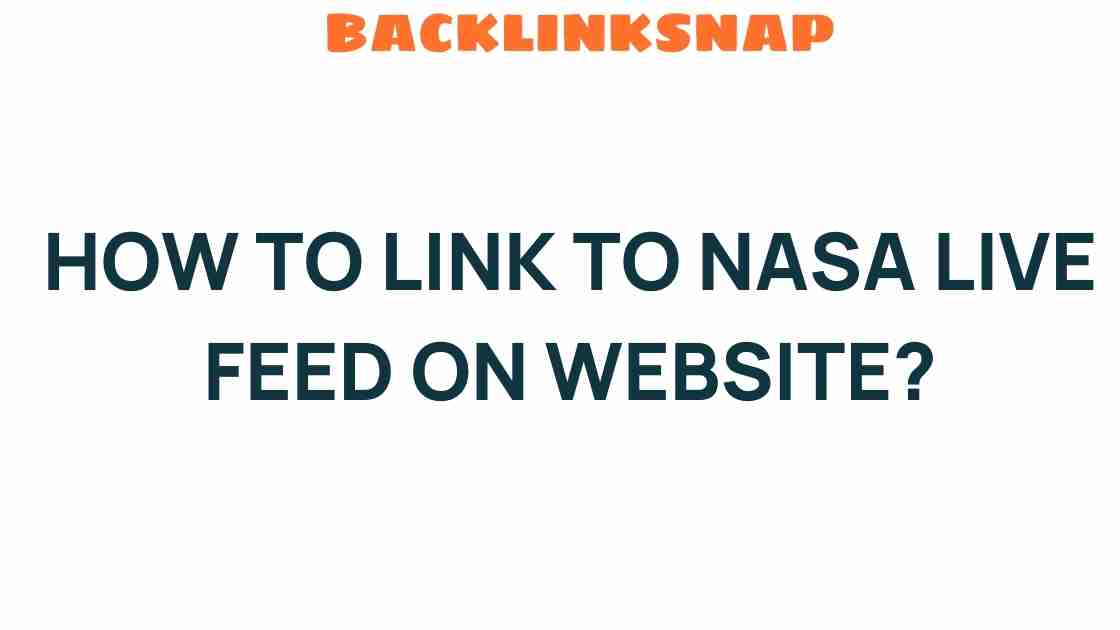Discover How to Link to NASA Live Feed on Your Website Effortlessly
In an age where information travels at lightning speed, the allure of space exploration captivates many. Thanks to NASA’s live feed, enthusiasts can witness the wonders of the universe in real-time. Integrating this live stream into your website can enhance online engagement and serve as a valuable educational resource. In this article, we’ll delve into how to easily embed the NASA live feed into your site, ensuring you provide your audience with a continual stream of awe-inspiring multimedia content.
The Importance of NASA Live Feed
The NASA live feed is more than just a window into space; it’s a bridge to understanding our universe. By featuring this live stream on your website, you can:
- Engage your audience with real-time updates from space missions.
- Educate viewers on various astronomical phenomena.
- Encourage interest in STEM (Science, Technology, Engineering, and Mathematics) fields.
- Provide a unique multimedia experience that sets your site apart.
How to Embed the NASA Live Stream
Embedding the NASA live feed on your website is a straightforward process. Here’s a step-by-step guide to help you through:
1. Find the Right Embed Code
First things first, you need to access the official NASA website where the live feed is hosted. The URL is frequently updated, so it’s best to start at the NASA homepage and navigate to the live stream section. Once you’re there, look for the embed options. NASA typically provides an HTML embed code that you can easily copy.
2. Insert the Embed Code into Your Website
Next, go to the backend of your website. If you’re using a content management system (CMS) like WordPress, follow these simple steps:
- Open the page or post where you want to display the live feed.
- Switch to the HTML or Text editor view.
- Paste the embed code you copied from NASA.
- Preview your changes to ensure the feed displays correctly.
For static websites, simply paste the code into the appropriate HTML file where you want the live feed to appear.
3. Adjust the Size and Format
The default settings of the embed code might not fit perfectly into your website’s design. Adjust the width and height parameters within the code to ensure it aligns seamlessly with your layout. A common configuration is to set the width to 100% for responsive design, allowing the feed to adapt to different screen sizes.
Best Practices for Integrating NASA Live Feed
While embedding the NASA live feed is simple, there are practices to enhance its effectiveness:
- Provide Context: Include a brief description or title above the feed explaining what viewers are watching. This helps in educational engagement.
- Interactive Features: Consider adding interactive elements like chat or Q&A sessions related to the feed to boost user engagement.
- Regular Updates: Ensure that the feed is active and functioning. Regularly check for updates or changes to the embed code as NASA might change their streaming service.
Benefits of Adding NASA Live Feed to Your Website
Incorporating the NASA live feed isn’t just about having a cool feature on your site; it has significant benefits:
- Increased Traffic: Unique content like live feeds can attract more visitors, increasing your website’s traffic.
- Enhanced Learning: It serves as an educational resource, allowing you to share knowledge about space exploration with a broader audience.
- Building a Community: A website that features engaging content can cultivate a community of space enthusiasts, fostering discussions and shared interests.
Leveraging NASA Live Feed for Online Engagement
Using the NASA live feed not only enriches your website but also encourages interaction. Here are ways to leverage it for online engagement:
- Social Media Sharing: Promote your live feed on social media platforms. Share snippets or highlights to draw viewers back to your site.
- Content Creation: Create blogs or articles discussing the events being streamed. This can enhance your site’s content and keep visitors informed.
- Collaborations: Partner with educational institutions or online communities that share a focus on space exploration to broaden your reach.
FAQs about embedding NASA live feed
1. Can I use the NASA live feed for commercial purposes?
NASA’s media is generally available for public use, but it’s essential to review their specific usage guidelines to ensure compliance.
2. How often does NASA provide live feeds?
NASA offers live feeds during significant events such as rocket launches, spacewalks, and other mission activities. You can check their schedule online for upcoming events.
3. What if the feed doesn’t work on my website?
If the feed doesn’t appear, verify that you’ve copied the correct embed code and that there are no restrictions from your website’s settings. Additionally, check for any updates on NASA’s site.
4. Can I customize the appearance of the live feed?
Yes, you can adjust the dimensions in the embed code to better fit your website’s design, ensuring a seamless look and feel.
5. Is there a way to notify viewers about upcoming streams?
Yes, you can create a dedicated section on your website or use a mailing list to inform users about upcoming NASA live events.
6. Are there educational resources available alongside the live feed?
Absolutely! NASA provides a wealth of educational resources that can complement the live feed, enhancing the learning experience for viewers.
Conclusion
Integrating the NASA live feed into your website is an exciting opportunity to engage your audience with real-time updates from the final frontier. With a few simple steps, you can provide a rich multimedia experience that not only informs but also inspires. Whether you’re an educator, a blogger, or a business owner, embracing this live stream allows you to be part of a larger conversation about space exploration. So why wait? Start embedding the NASA live feed today and watch your online engagement soar!
This article is in the category Digital Marketing and created by BacklinkSnap Team




